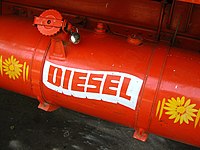
Photo from wikipedia
The growing global demand for fossil fuels and considerable environmental threats and risks have prompted researchers to launch investigations over some renewable energy sources in recent years. Especially biodiesel and… Click to show full abstract
The growing global demand for fossil fuels and considerable environmental threats and risks have prompted researchers to launch investigations over some renewable energy sources in recent years. Especially biodiesel and ethanol have been considered as major alternative fuels as they are derived from renewable sources. These fuels are well oxygenated and therefore have a great potential to reduce emissions. Biodiesel, which is chemically derived from edible oils or animal fats by transesterification reaction, is esters of long-chain saturated/unsaturated fatty acids and can be an important alternative fuel source to consider for the vehicle. It can offer desirable features to diesel engines, and internal combustion engines (ICEs) in particular. The present study aims at determining and assessing the effect of the engine's load and speed as well as various ratios of diesel and biodiesel fuels blending on the emissions of pollutants from the OM 314 diesel engine. Design Expert 11 statistical software was used. Second-order models obtained using response surface methodology (RSM) to predict the effect of input variables on response surfaces were statistically significant at an alpha level of 1. Following an increase in the percentage of biodiesel compared to pure diesel fuel, the HC (Hydrocarbons) emission rate decreased. According to the optimization results, the lowest HC emission rate (33.52 ppm), and the least NOX emission rate occurs when using 8.82% biodiesel. The lowest HC emission rate was observed after using pure biodiesel fuel. Following an increase in the percentage of biodiesel in the blended fuel, the NOX emission rate increased, while the lowest emission rate was observed after using pure diesel fuel. Engine smoke flow rate decreased after increasing the percentages of biodiesel in blended fuel compared to diesel fuel. A higher percentage of biodiesel was considered as the most effective way to reduce the rate of smoke opacity. According to the multi-objective optimization (MOO) results, the lowest HC, and NOX emission rates and the rate of smoke opacity was observed for blended fuel "D32.47B67.53" with the Desirability of 60% under applying a load of 41.36% and rotational speed of 1383 rpm.
Journal Title: Journal of oleo science
Year Published: 2020
Link to full text (if available)
Share on Social Media: Sign Up to like & get
recommendations!